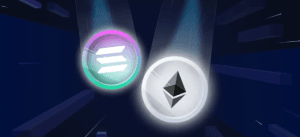Solana vs Ethereum: The Battle for Blockchain Supremacy
Introduction to Blockchain and Its Evolution
Blockchain technology emerged in 2008 with the publication of the Bitcoin whitepaper by an individual or group using the pseudonym Satoshi Nakamoto. This revolutionary technology introduced a decentralized and transparent ledger system that would enable secure transactions without the need for intermediaries. The inherent characteristics of blockchain, such as immutability, transparency, and decentralization, have garnered significant attention, laying the groundwork for the future of digital currencies and decentralized applications.
Initially, blockchain served primarily as the underlying framework for cryptocurrencies. However, its applications have expanded widely beyond simple financial transactions. The decentralized nature of blockchain led to the development of smart contracts, which are self-executing contracts with the terms of the agreement directly written into code. These innovations paved the way for platforms like Ethereum, launched in 2015, which introduced programmability to the blockchain, allowing developers to build decentralized applications (dApps) and broaden the use cases of blockchain technology.
Ethereum’s unique attributes, such as its capability to support complex smart contracts, positioned it as a pioneer in the blockchain space and earned it the moniker “the world computer.” Yet, Ethereum is not without its challenges, including scalability issues and high gas fees during periods of network congestion. This paved the way for alternative blockchain solutions, such as Solana, which was launched in 2020 and aims to address these issues with a focus on speed, efficiency, and lower transaction costs. Solana’s rise has earned it the label of an “Ethereum killer,” as it competes to establish itself as a superior platform for developers and users alike.
As the competition intensifies between Solana and Ethereum, understanding their technological foundations, use cases, and inherent strengths will be crucial in assessing their roles within the evolving blockchain ecosystem. The dialogue surrounding solana vs ethereum not only highlights their respective challenges but also illustrates a broader race for dominance in blockchain technology.
Comparative Analysis of Solana and Ethereum
The discussion surrounding Solana vs Ethereum continues to capture the attention of blockchain enthusiasts and developers alike. As two of the leading platforms in the decentralized application (dApp) landscape, their contrasting approaches to transaction speeds, consensus mechanisms, and scalability serve to define their unique positions within the blockchain ecosystem.
Ethereum, the pioneering blockchain, initially operated on a proof-of-work (PoW) consensus mechanism, which facilitated its functionality but also resulted in significant limitations regarding transaction speed and energy consumption. However, the transition to a proof-of-stake (PoS) model through Ethereum 2.0 aims to rectify these issues. PoS allows for greater efficiency, allowing validators to confirm transactions without the energy-intensive mining processes of PoW. This shift is anticipated to enhance transaction speeds and scalability, aiming to address Ethereum’s long-standing contention with high gas fees—a critical factor when evaluating Ethereum’s performance against its competitors.
Conversely, Solana has adopted a distinct approach through its innovative proof-of-history (PoH) mechanism. This technology enables the platform to process thousands of transactions per second, thereby achieving unparalleled speed. Solana’s architecture is specifically designed to prioritize efficiency and scalability, making it a prime candidate for applications requiring rapid transaction confirmations. Its performance has positioned Solana as a contender frequently labeled an “Ethereum killer,” especially due to its lower transaction costs and faster speeds, which appeal to developers seeking reliable smart contracts and a responsive user experience.
The blockchain speed comparison between Solana and Ethereum highlights not only their technical frameworks but also their cultural and economic implications within the blockchain space. As both platforms evolve, understanding their respective strengths and weaknesses will be essential for developers and users navigating this dynamic ecosystem.
Use Cases and Ecosystem Growth
Both Solana and Ethereum have made significant strides in establishing themselves as leading platforms for decentralized applications (dApps) and non-fungible tokens (NFTs). While Ethereum has long been recognized as the pioneer in the smart contract space, Solana has rapidly gained attention for its robust ecosystem and enhanced architecture. The comparison between these two blockchains showcases their unique strengths and the vast array of use cases they support.
Ethereum, often dubbed an “Ethereum killer,” boasts a vast community of developers and users. Its network serves as a foundation for thousands of dApps, spanning sectors from finance (DeFi) to gaming, art, and beyond. With its pioneering introduction of ERC-721 and ERC-1155 standards, Ethereum has positioned itself as the dominant force in the NFT market, successfully facilitating unique digital ownership through widespread adoption in various industries.
In contrast, Solana has emerged as a formidable contender by offering remarkable speed and low transaction costs. This blockchain speed comparison highlights Solana’s capacity to process thousands of transactions per second, positioning it as an attractive alternative for developers. The increased throughput allows for innovative applications that require real-time interactions, such as decentralized finance protocols, gaming apps, and logistics solutions. With its ecosystem growing rapidly, Solana is appealing to both new and existing developers looking to maximize efficiency in their projects.
The success of these ecosystems is intrinsically linked to community support and developer engagement. Both platforms have significantly invested in creating frameworks that enable developers to create, deploy, and scale their applications. Ethereum has initiatives like its scaling solutions and institutional partnerships, while Solana’s ecosystem benefits from strategic collaborations and substantial venture capital funding.
Looking toward the future, the continued growth of both Solana and Ethereum’s use cases and ecosystems will likely shape the landscape of smart contracts and dApps. As adoption rates increase and more developers engage, the competition in the blockchain space will intensify, making the exploration of solana vs ethereum increasingly critical for innovators and investors alike.
The Future of Blockchain: Predictions and Challenges
The future of blockchain technology promises to be both exciting and challenging, particularly in the context of the ongoing competition between Solana and Ethereum. As the popularity of decentralized finance (DeFi) and non-fungible tokens (NFTs) continues to grow, both platforms will need to evolve to meet the demands of their users. A key area of focus will be the scalability and speed of transactions, which has been a significant factor in the solana vs ethereum debate. With Solana’s impressive speed and lower transaction costs, it has garnered attention as an “Ethereum killer.” Conversely, Ethereum is making strides with its transition to Ethereum 2.0, which aims to enhance performance through a proof-of-stake consensus mechanism.
Nevertheless, both platforms face considerable challenges. Regulatory scrutiny is one potential hurdle that could impact their development. Governments worldwide are increasingly looking to implement regulations that may affect how these blockchain networks operate. This aspect of the blockchain speed comparison could alter the landscape for both Sol and ETH. Moreover, technological limitations, especially concerning smart contracts, could present obstacles. Ethereum’s network congestion has historically led to higher fees, whereas Solana’s rapid transaction processing must prove its resilience over time.
Market dynamics introduce another layer of complexity. As new players enter the blockchain arena with innovative features and greater efficiency, both Ethereum and Solana must continuously adapt to remain competitive. Predictions suggest that a multi-chain world may prevail, where various platforms coexist, leveraging their unique strengths and capabilities. Alternatively, either Solana or Ethereum could emerge as the dominant leader in the space. The trajectory of this competition will ultimately depend on how each platform addresses its challenges while capitalizing on growth opportunities in the evolving landscape of decentralized technologies.





Post Comment